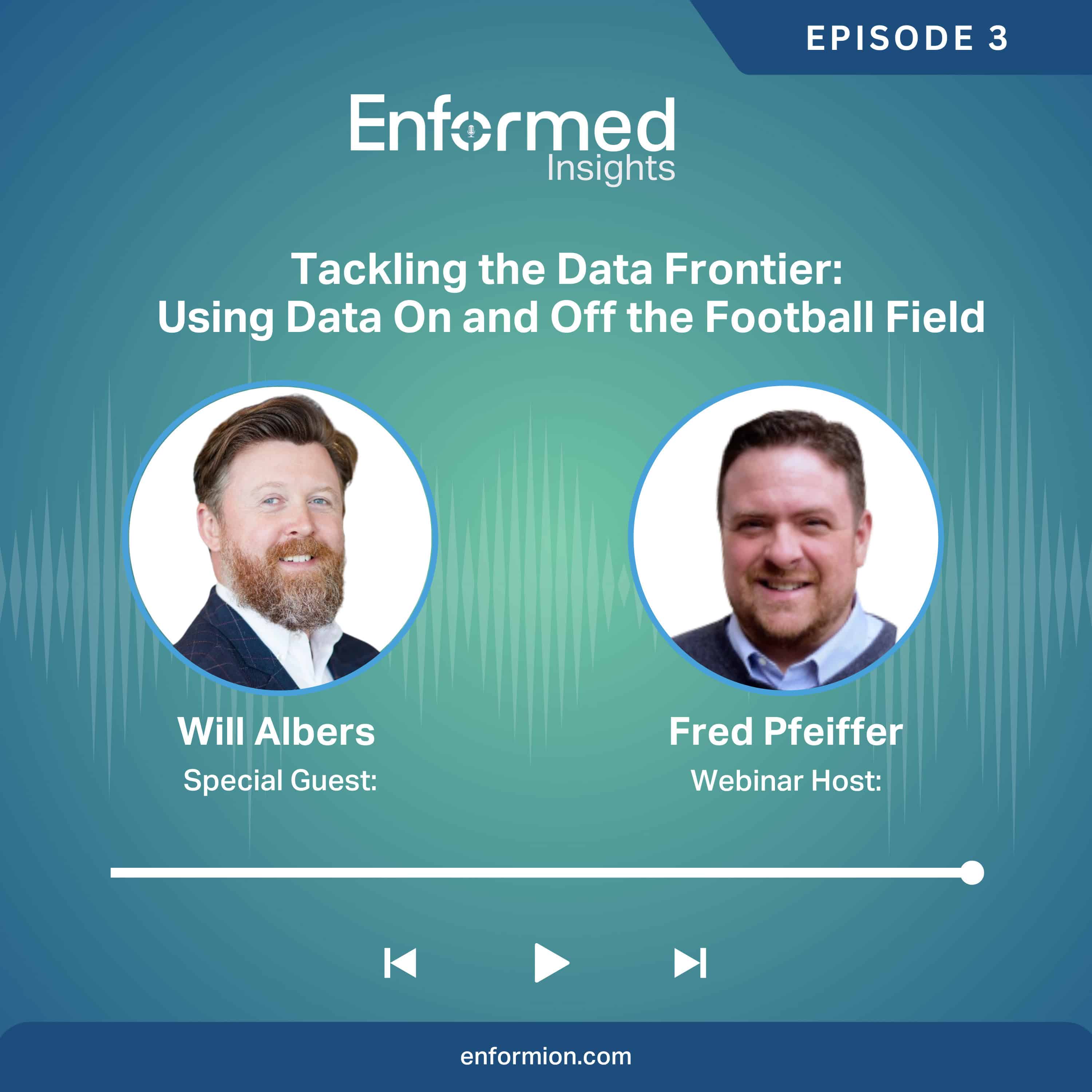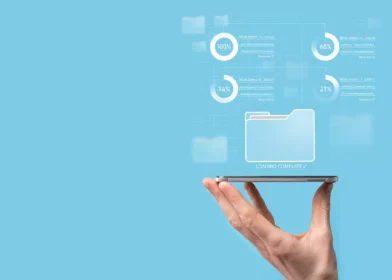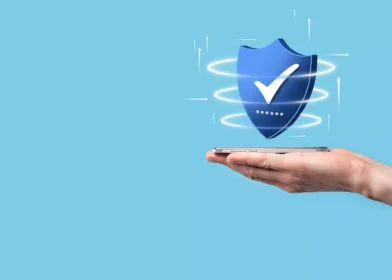Episode 3: Tackling the Data Frontier – Using Data On and Off the Football Field

Stream on these platforms:
Click play below to listen:
In this episode, we sit down with special guest Will Albers, a seasoned industry leader with 20 years of experience in data acquisition, governance, and customer data management, to discuss the impact great data can have on and off the football field. Throughout his career, Will has transformed data and analytics organizations, driving innovative solutions at prominent companies such as Dun & Bradstreet, Ford Motor Company, and the NFL.
Key Discussion Points:
- Staying current with data acquisition
- Significant trends in consumer data
- Data sharing strategies and success
- Core data preferences and accuracy reliability
0:02
Welcome to Enformed Insights, the official podcast of Enformion.com and your guide to the world of public records and data analysis. Join our host, Fred Pfeiffer, as he interviews industry experts and shares practical tips for navigating the future of digital information.
0:15
Hello again, and welcome to another edition of Enformed Insights. Today, we’re honored to have Will Alberts, Senior Director of Data Acquisition for the NFL, as our esteemed guest. Will, how are you today?
0:26
Will: Doing very well, thanks. Thanks for having me, Fred. I’m excited to be here.
0:31
Fred: We’re so excited to have you, Will. It’s a beautiful sunny day here in Chicago, and the outlook for my beloved Bears is equally bright, so I’m in a fantastic mood for this conversation. Thank you so much for taking the time to chat. I’d like to start out with your career path to the NFL. Can you share a bit about your journey and what drew you into this area of expertise?
0:48
Will: Yeah, sure. I’ve been thinking a lot about this recently. You get to that mid-career point and look back at where you started. It’s been about 20 years in the data and analytics industry, and I’d focus on the last decade, which has been primarily focused on data acquisition. Depending on who you talk to, you may get a different definition of data acquisition, but I can explain my perspective.
1:19
Way back, I was living in the Washington, D.C. area and supporting the military and intelligence communities, using predictive analytics to locate potential threats based on where they had been. We would get deployed to major command centers and be tasked with standing up a cell to support a specific geography, like North Korea. Our job wasn’t to sit down with a large data set and start analyzing; we had to find and piece together data from scratch, using intelligence and open-source data. This idea of acquiring data for analytics became a recurring theme as we moved to new responsibilities and geographies.
2:15
Eventually, we moved out of the D.C. area, and I focused on commercial data for a while, working for Dun & Bradstreet. My role involved integrating data from various sources with commercial data to answer questions and tackle problems. After that, I moved to Ford Motor Company, entering the manufacturing sector. There, we stood up a data and analytics cell that took things to a new level, specifically focusing on data acquisition.
2:57
From there, I went into retail, working for a large grocery chain in Canada, focusing on consumer and external data. Now, I’m in the entertainment industry, working with NFL data and externally sourced data to engage with our fans in meaningful ways.
3:19
Fred: What have been some pivotal moments in your career that have shaped your understanding and approach to consumer data?
3:25
Will: One interesting thing is that every organization defines consumer data and its problems differently. While we may repeatedly talk about “consumer data,” each industry and company values different aspects. The operational definition of “consumer” can shift significantly. Are we targeting existing consumers, or are we looking for new ones? These distinctions impact how we search for and use data.
4:20
Fred: What are some of your proudest accomplishments in your work?
4:26
Will: I think my proudest accomplishments include both human and professional dynamics. On the human side, I’ve had the privilege of leading teams, guiding their careers, and seeing them grow into exceptional data and analytics professionals. On the professional side, I’m proud that my expertise is recognized. When people at my previous companies think of consumer data and data acquisition, they often bring up my name, knowing I’m passionate about the topic.
5:22
Fred: Can you discuss a project or initiative that had a significant impact on the industry or your organization?
5:29
Will: Much of what I do is behind the scenes, creating additional data collections that enable other analytic efforts to shine. For example, projects involving identity resolution or improving marketing effectiveness through one-to-one consumer engagement have had high impact, even if my role was more foundational than visible.
6:24
Fred: What are some key lessons you’ve learned about managing and leveraging consumer data?
6:31
Will: Each company defines consumer data differently, so a “rinse and repeat” approach doesn’t work. For example, at a large grocery retailer, we discovered that a significant portion of their data was duplicated. Loyalty programs often issued multiple cards to the same customers, creating inflated customer counts. This was a valuable lesson in how assumptions can be misleading and in the importance of careful data validation.
8:20
Fred: Can you share any mistakes or challenges you’ve faced and how you overcame them?
8:26
Will: One common challenge is culture. Changing a long-standing data practice or metric can be difficult, especially when people are attached to certain numbers or methodologies. A lesson I’ve learned is to build trusted relationships before making major changes to a company’s data and analytics strategy.
9:12
Fred: What advice would you give to someone looking to enter the field?
9:18
Will: Don’t make it just a job; cultivate a passion for it. Find mentors and leaders who inspire you, and learn from them. I’ve been fortunate to work with amazing leaders who have influenced my career and stayed with me from company to company.
10:14
Fred: How can professionals stay current in the rapidly evolving landscape of consumer data?
10:19
Will: One approach we use is performing a “vendor landscape” analysis yearly or semi-annually to assess current data providers and identify new players. With the growing availability of data sources, it’s important to continuously review options for accuracy, cost, and relevance.
11:25
Fred: Can you describe the current landscape of consumer data collection and analysis? What are the most significant trends you’re seeing?
11:31
Will: It’s back to basics. Consumer data typically falls into three categories: first-party data (collected directly), third-party data (sourced externally), and partnership or sponsorship data. Partnerships, for example, allow us to access rich data about consumer engagement through collaborations. At the NFL, we receive valuable data from our sponsorships that gives us insights into fan engagement that we wouldn’t have otherwise.
14:54
Fred: You’ve been in this space for a long time. Do you have a ballpark estimate for how much consumer data changes annually?
Here’s the transcript with timestamps:
15:15
Fred: Let’s talk about core data assets—name, phone, email, and physical address. Do you feel the velocity of change in these assets is increasing compared to 10 or even 20 years ago?
15:21
Will: Yes, absolutely. I like to use an acronym, “NEPA”—name, email, phone, and address. This core PII forms the backbone of consumer data in a CRM. Each element changes at its own rate, and I think that makes sense intuitively.
For example, your last name doesn’t change very often. Maybe once in a lifetime, occasionally a couple of times. It’s relatively static but very impactful when it’s correct. People respond well when their names are right and, honestly, it feels a bit funny when they’re not.
16:03
If we move to email—email is tricky. It can cause problems if not handled carefully, and we see a lot of churn in email addresses and domains. For instance, educational institution emails often get deactivated once students graduate, unlike Gmail or other long-term domains. I strongly recommend using a validation service to keep emails accurate.
17:10
Next, the physical address—I’m personally a bit of an outlier since I’ve moved a lot for work, but for most people, their address is second only to their name in importance. Receiving mail at the wrong address, especially for products, can be frustrating and might turn someone off from engaging with the company in the future.
17:51
Lastly, phone numbers are unique. With the shift to cell phones, people tend to keep the same number for decades. I’ve had mine since around 1995. Cell phone data is more stable and less expensive to maintain but important for SMS marketing, which many companies are leaning into as app marketing gets more restricted.
18:35
Overall, keeping NEPA data accurate and current is crucial, and companies need external support to manage this effectively.
18:48
Fred: How do you balance the need for consumer data with concerns around privacy and security?
18:56
Fred: Privacy and security always come first. The question isn’t about balancing these with consumer data; it’s about respecting regulations and consent. Privacy consent is central to everything we do with consumer data, from who shares it with us, to whom we share it with, and where we source it.
19:50
Consumer trust is essential. When I was at Ford, we were approached by Cambridge Analytica about consumer information. We scrutinized their sourcing and consent processes, but their answers were vague. We chose not to engage with them, which turned out to be the right decision once their questionable practices came to light. This diligence is critical when evaluating vendors.
20:44
Fred: What are some best practices you recommend for companies to ensure consumer data privacy and security?
20:51
Will: It’s an interview process when I’m sourcing data. I ask direct questions about data sourcing and consent. Over time, you learn to ask the right questions and interpret vague responses. I’ve also become skilled at contract negotiation, making sure there are safeguards in place for any reputational risk or liability that might arise from improperly sourced data.
21:44
Fred: Can you share innovative ways businesses are using consumer data to enhance customer experience and drive growth?
21:51
Will: Absolutely. One approach I like is “one-to-one” marketing, which I learned from an expert I’ve followed for over a decade. He frames it as “see, know, and engage.”
22:03
Most companies can “see” their consumers—they know who bought something. But they don’t truly “know” them beyond basic details. Moving to the next level requires understanding demographics, social structure, income, and interests, which allows you to market meaningfully.
23:18
When you have fresh, comprehensive data, you can move to true one-to-one marketing. Rather than broad segment targeting, it’s more personal—e.g., “I noticed you attended a Yankees game, here’s something tailored to that interest.” It’s possible today due to data services that enable meaningful engagement at scale.
24:07
Fred: How do you see advancements in AI and machine learning shaping the future of consumer data?
Will: AI is a great scaling tool. It’s not yet ready to independently generate data, but it can process vast information efficiently. I envision AI being used to aggregate new data sources, enabling us to predict consumer behavior more accurately. However, it will take time to reach a level where it truly transforms data collection.
Fred: How do you anticipate upcoming regulations in the EU and California will impact data handling?
25:43
Will: This can be frustrating. Regulations vary, and in some countries, even subtle details like how a name is addressed can be sensitive. I think it’s critical for companies to provide transparency and control—let consumers view, correct, and manage their data preferences.
27:29
Fred: Do you think the US will eventually adopt EU-style regulations?
27:34
Will: I don’t think so. I think California will be about as strict as it gets here. There’s strong lobbying in the US, and marketing is such a major industry that any regulations limiting it too much would likely face resistance.
28:09
Fred: What strategies should companies use to stay ahead of regulatory changes?
28:16
Will: In my opinion, the best approach is to engage consumers in ways that don’t annoy them. Engage meaningfully so they don’t feel spammed or disconnected. When companies respect their consumers, privacy issues tend to be minimized. Organizations that operate with a shotgun approach, targeting consumers broadly, often generate the negative feedback that leads to regulatory scrutiny.
29:06:
Fred: Will, I can’t thank you enough for discussing these important issues with us today. As a final question, how do you think changing consumer behavior will impact the future of data collection and analysis?
29:17
Will: I hope companies recognize the importance of tracking small engagement signals over time. The journey of a young fan attending NFL games, for instance, can grow into a significant customer relationship. It’s only recently that companies started seeing the value in this kind of long-term, data-driven nurturing of relationships.
30:15
Thank you for listening to Enformed Insights. To learn more or listen to another episode, please visit Enformion.com.

Ready To Get Started?
Contact us today to request a demo or to get in touch with one of our Data Solution Experts
Talk With Us

